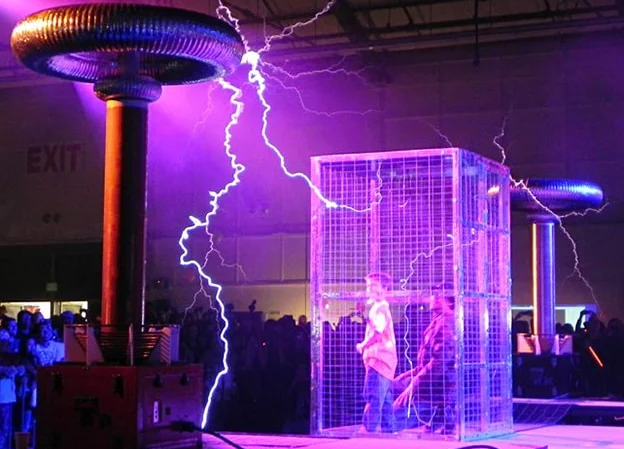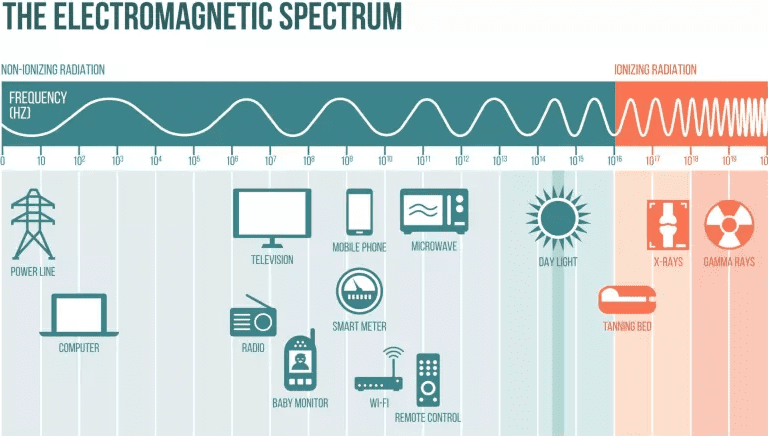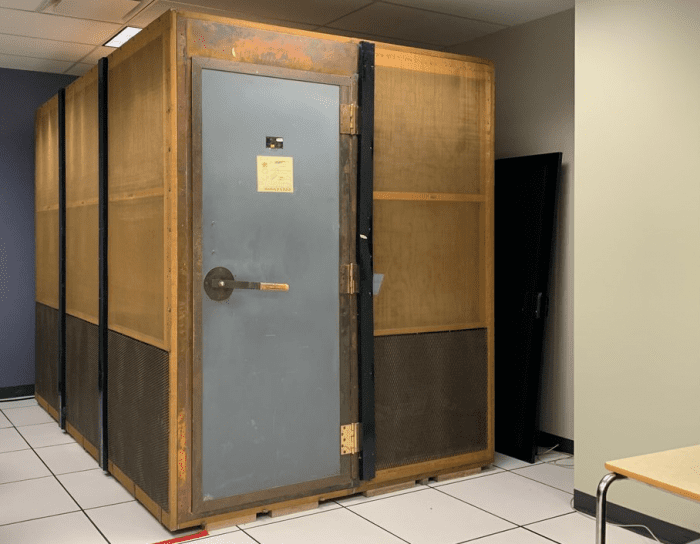Can you imagine your life without smartphones, GPS, Bluetooth, or social media sites like Instagram and Twitter? Sounds weird, but that reality was just 20 years ago. Technology and the way we communicate are changing rapidly, with advanced gadgets making our lives easier than ever.
But, there is a downside to these remarkable innovations. The growth in technology and modern gadgets has filled our homes with EMF pollution. You are probably exposed to many electromagnetic fields as you’re reading this right now. That is precisely why we are going to show you how to make a Faraday cage room. A Faraday cage can help you isolate EMF sources and protect yourself from radiation.
A Faraday cage or shield is an enclosure that is used to block electromagnetic fields. Faraday cages are already everywhere around us; you probably even own one. Things like Wi-Fi routers, laptops, tablets, and Bluetooth devices emit enormous amounts of radiofrequency and electromagnetic radiation. And, with 5G set to fully replace the 4G mobile networks in the upcoming years, that radiation will increase exponentially.
Having the knowledge to build a Faraday cage room will come in handy, and we’ll be discussing why you should do it, how to do it, and how it will help you.
The Faraday Cage Room Explained
Named after the English scientist Michael Faraday, who invented electromagnetic induction and the technology that makes shielding against electromagnetic radiation possible.
A Faraday cage room is an enclosure that stops the radiation from electric fields. The cage is made from materials that can conduct electricity, like a covering of conductive metal mesh.
It serves both against electromagnetic energy coming from the external environment, and it blocks EMF radiated from the internal components from escaping the cage.
How it works
In short, the cage creates a barrier between the device’s internal components and electric fields from the outside.
The external electric field redistributes the electric charges within the enclosure and its conducting material, canceling the field’s effect inside the cage. Because of this, the electrical components inside the Faraday shield can function properly and won’t be interrupted.
This phenomenon is used to protect sensitive equipment from external radio frequency interference. It works both ways, protecting people and equipment on the outside, as well as working as a shield against lightning strikes and electrostatic discharges.
Faraday cages cannot be used to block magnetic fields that are constantly varying, like the Earth’s magnetic field, so you can still use a compass instead of one.
Applications of the Faraday Cage
Faraday cages are handy tools, especially for people who work with electricity and electronics.
In this article, we will focus on its home applications for shielding against harmful EMF radiation, but here are a few examples of the practical use of the Faraday cage. Related: EMF Shielding: In-Depth Guide for Home Protection
Shielding electronic equipment from electromagnetic interference (EMI)
Electronic equipment and appliances are present everywhere, so it’s crucial to protect various equipment from the electromagnetic radiation from other electronics in its environment.
For example, coaxial cables used for cable TV are made with a copper braided shield beneath the PVC jacket, which essentially acts as a Faraday cage that protects the internal conductors from electrical noise and prevents RF radiation.
Microwaves
If you own a microwave, you know how much EMF radiation it can emit. That’s why all microwaves come with their own built-in Faraday cages. The metal shell in your microwave is a Faraday cage room, preventing the microwaves from the oven from leaking into the environment. Related: Is a Microwave a Faraday Cage?
Magnetic Resonance Imaging (MRI)
Faraday enclosures are used in MRI scan rooms, preventing any external radio frequency signals from distorting the data coming from the patient.
Protection for electricians
Electricians and linemen wear protective suits in hazardous environments like high voltage power lines. The suits act as a Faraday cage that protects the workers from being electrocuted. Related: How to Block EMF From Power Lines
Guard from lightning
You’ve probably heard from somewhere that lightning never strikes a car.
Things like cars and airplanes are made from metal compartments, and they act as a Faraday cage protecting their passengers from lightning charges.
Military use
The army uses room-sized Faraday cages when sensitive information is being discussed because surveillance devices can’t penetrate them. The military also uses them to protect valuable electronics from electromagnetic pulses.
EMF Radiation Explained
The most simple example of EMF radiation is sunlight. We can see the energy from the sun radiating out in the form of visible sun rays.
But, with electricity and power lines spreading across our world, we learned that they too were sending off EMFs just like the sun.
Electrical machines like microwaves, CT scanners, X-rays, Wi-Fi routers, Bluetooth devices, and more give off significant EMF radiation. Related: How to Reduce Bluetooth Radiation
Electric and magnetic fields join as one field resulting in an electromagnetic field (EMF). You can get exposed to two types of EMF radiation:
- High-frequency EMFs: This is called an ionizing type of radiation. Prolonged exposure can damage your DNA and cells. Medical devices like X-rays produce this type of radiation.
- Low-frequency EMFs: This is a non-ionizing radiation type. Many scientists agree that it is harmless to people, but the dangers are not to be underestimated. Things like microwaves, cellphones, washing machines, etc., give off this type of radiation.
The most common sources of EMF radiation
- Microwave ovens
- Computers and laptops
- Cellphones and tablets
- Smart meters
- WiFi routers and modems
- Bluetooth devices
- Power lines
- MRI
- X-Ray machines
- Dirty electricity
Health risks from EMF radiation
The most commonly occurring symptoms of exposure to EMF radiation include:
- Headaches
- Insomnia and sleep disturbances
- Fatigue and tiredness
- Anxiety and restlessness
- Depression
- Memory changes
- Hard time concentrating
- Dizziness
- Nausea
- Loss of appetite
Faraday Cages to Protect Health
Before we discuss how to make a Faraday cage room, we need to talk about EMF and personal health.
Since the invention of the light bulb and the electrical network designed to support it, we’ve been slowly getting exposed to EMF radiation. The volume of that radiation hasn’t been a problem until recently with the addition of many electronic home appliances and wireless devices in our homes.
Starting with the 2G network infrastructure that supports wireless communications and text messages, EMF radiation has gone through the roof. More and more technologies have been introduced since then, making the EMF pollution in our environment much more prevalent.
The Faraday cage is more relevant than ever
Although the wireless industry has made our lives much easier and way more convenient, it’s not without a price. Hundreds of research studies have said that EMF exposure can result in several mental and physical health problems.
Using EMF protection to deflect harmful RF radiation is not the best solution. The best thing you can do is minimize the use of EMF emitting devices altogether and keep as much distance between you and EMF sources in your home and office.
But this is a technology-driven world, and simply going offline is not an option. The addition of 5G towers and mini cell receptors will be making EMF more present than ever. Related: What is a Safe Distance From a Cell Tower
So, the best form of protection you have right now is learning how to build a Faraday cage room or investing in some protective products. Related: How to Build a Faraday Cage to Sleep In
How to Make a Faraday Cage Room
Okay, now that you’ve been introduced to EMF radiation and the health risks associated with the exposure, it’s time to protect yourself.
Building the Faraday cage room
- Buy a woven metal mesh.
- Buy small wood strips.
- Get a stapler.
- Measure out a rectangle size like 8 x 16 inches.
- Measure and cut five wood strips, each 8 inches long.
- Slowly unroll the metal mesh rectangle until it lays flat.
- Start stapling the metal mesh through the wood strips.
- Staple the first strip at the end of the metal mesh.
- Staple the second strip around 5.5 inches away from the first strip, length-wise.
- Staple the third strip at 2.5 inches distance from the second strip.
- Staple the fourth strip 5.5 inches distant from the third strip.
- To complete the box, staple the fight strip at the far end of the mesh.
- The wooden strips act as braces, so after stapling them as instructed, fold the mesh at each strip to create a rectangular box.
You’re all done, and now you have a protective Faraday cage in the form of a metal mesh box. You can place anything that emits EMF radiation within that box to protect yourself.
Faraday cage room for cellphones
If you want to test out how a Faraday cage room works on a cellphone, you can use aluminum foil to create an impromptu Faraday shield. You can also test the built-in microwave protection using your mobile phone.
- Call your cellphone and confirm that it rings.
- Next up, put your phone in the microwave (while it’s turned off).
- Call your phone from another place.
- Will it ring?
- Try using your cellphone to call your home number. As soon as you hit the call button, quickly put and close the cellphone inside the microwave. Is your house phone ringing?
- Finally, the easiest method to test out the effectiveness of a Faraday cage room is aluminum foil.
- Wrap up your phone in aluminum foil and try calling it.
Frequently asked questions
How does a Faraday Cage work?
A Faraday cage is simply a container made up of conductive material (metal) used to block electromagnetic radiation by creating a field around the cage’s exterior, protecting the device inside the cage from any external radiation.
It can also be used to stop radiation coming from inside the said device.
What’s the legal status of Faraday cages?
It’s completely legal to buy, own, or create a Faraday cage room. Electronic jamming devices are illegal, but this is on the other side of the spectrum. Plus, you already have small Faraday cages around your house, like inside your microwave, TV cables, ovens, etc.
They are commonly used in power plants, airplanes, buildings, etc.
Are there any places where I can buy a Faraday cage?
Yes, you can find many stores that sell Faraday cages online. You can buy a Faraday shield for many different uses. There are small-sized cages like bags and pouches for phones and cameras, as well as big Faraday tents for your car. Related: Best Faraday Pouch
Can I use aluminum foil to make a Faraday cage?
Yes, any conductive material can be used to create the cage. You can use aluminum foil as long as it has no holes and rips in it, and you put an insulating layer between the surface and the item you’re protecting.
Can a Faraday cage be penetrated?
Faraday cages shield the interior from electromagnetic radiation, but some types of radiation can’t be blocked. This is the case for slowly varying magnetic fields. Our planet’s magnetic field is the best example of this, so a compass will still work inside the Faraday cage room.
How can I Faraday cage my house?
An improvised Faraday room can be made. You can use aluminum foil to cover up a small room or closet. You need to cover all four walls, the floor, and the ceiling with heavy-duty aluminum foil. You can tape it together using conductive cellophane tape.
Does a Faraday cage need to be grounded?
You don’t have to ground a Faraday cage for it to function properly and protect the electronics within. But, by grounding the Faraday cage, you will keep the cage from being charged with electricity that might be dangerous if you touch it.
The probability of a Faraday cage becoming charged with high levels of electricity is minimal.
Do Faraday cages block GPS?
Things like Faraday bags block all radio signals like RFID, Wi-Fi, GPS, Bluetooth, etc. If you want to prevent attacks on your devices, you can simply place them in your Faraday bag.
Conclusion: Making a Faraday cage
If you made it this far, by now, you’ve learned how to make your own cage and why you need one. EMF pollution is more significant than ever, and knowing how to build your own cage can prove to be very useful in the near future.
We hope this article has helped you understand the possible danger of EMF and how a Faraday cage can help you protect yourself and your devices.



